Japan Wood Products
Prices
Dollar Exchange Rates of
10th September 2015
Japan Yen 120.59
Reports From Japan
Growth prospects undermined by falling exports and
weak domestic demand
The Japanese economy contracted in the second quarter of
this year ( -1.2% annualised). Falling exports, especially to
China, will make a second half year recovery very
difficult.
Public spending and slightly better housing starts, the
result of changed tax structures has encouraged home
owners to demolish and rebuild, were the only bright spots
in an otherwise disappointing second quarter.
Domestic demand, the main driver of growth, was
subdued in the second quarter and the efforts of the
government and Bank of Japan (BoJ) to stimulate inflation
have not succeeded as yet.
With prospects for growth in the second half of the year
looking dim many in Japan are calling on the BoJ to
consider expanded fiscal stimulus. The Economy Minister
has expressed fears that weak demand in China will
seriously affect Japan and will undermine growth in most
Asian economies further affecting Japan‟s exports.
Robust improvement in consumer confidence index
The BoJ survey of consumer confidence during August
covered 8,400 households and response rate was 65.7%.
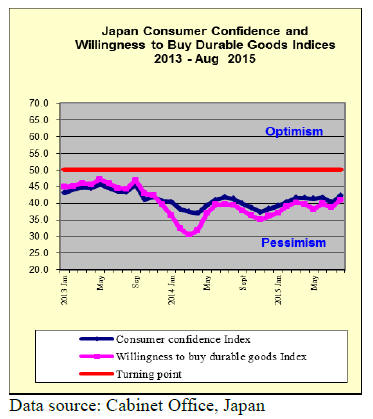
The overall Consumer Confidence Index in August rose to
41.7, up 1.4 points from the previous month, a surprisingly
robust improvement. The August figures for the various
components of the index (Consumer Perception Indices)
were as follows:
Overall livelihood: 40.1 (up 2.0 from July)
Income growth: 39.9 (up 0.3 from July)
Employment:46.3 (up 1.6 from July)
Willingness to buy durable goods:40.3 (up 1.5
from July)
The index measuring employment status improved as did
the income growth prospect index.
Second consecutive monthly dip in machinery orders
Machinery orders, a primary economic indicator in Japan,
fell in July. This was the second consecutive drop raising
the prospect that weak business investment will further
dampen the chances of sustained economic expansion.
August private sector machinery orders were down 3.6%
following on from the nearly 8% drop in July.
The Cabinet Office cut its assessment of core orders,
saying „the pickup is seen stalling‟ which has driven many
analysts, along with Cabinet Ministers, to call for further
economic stimulus measures.
For more see:
http://www.esri.cao.go.jp/en/stat/juchu/1507juchu-e.html
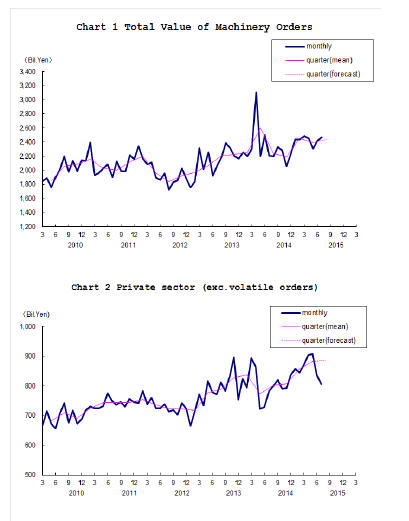
Rising profits of exporters not translating into higher
wages
With the yen already trading in the 120-124 range to the
US dollar, a 50% drop in just over two years, small sized
manufacturing companies that rely on imported raw
materials are facing tough times. With inflation stuck close
to zero manufacturers selling into the domestic market
cannot pass on the rising cost of production.
The rising fortunes of the big exporters due to the weak
yen have not translated into higher worker incomes and it
is here that Abenomics has run into a wall.
The weaker yen was the key to the early success of
government policy but the negative impact on small
companies which, after all, employ more works than any
other sector has economists and politicians worried.
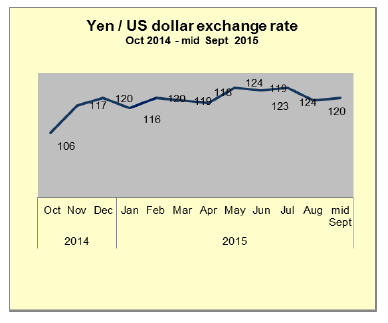
Import round up
Doors
Japan‟s July 2015 imports of wooden doors rose again
climbing just over 2% month on month. The July imports
of wooden doors were almost at the record level set in
December 2014.
China and Philippines continue as the top wooden door
suppliers accounting for just over 75% of Japan‟s July
imports of this product. If imports from Indonesia and
Malaysia are included then over 90% of wooden doors are
accounted for.
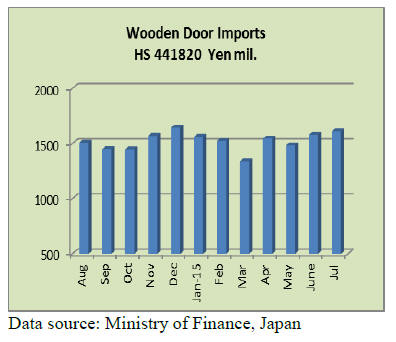
Windows
July wooden window imports were down around 9%
month on month and down 16% on July 2014.
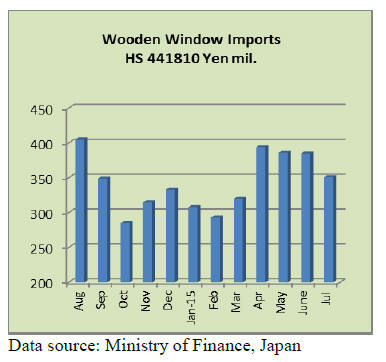
China tops the list of suppliers (36% of all wooden
window imports) followed by Philippines (30%) and the
US (21%). The top three supplires accounted for over 85%
of all wooden window imports in July.
Assembled flooring
July imports of assembled wooden flooring dipped sharply
reversing the gains made in June. Month on month, July
imports were down 18% and year on year they fell 39%.
As in previous months China is the largest supplier of
assembled wooden flooring accounting for 57% of July
imports.
Imports from Vietnam and Malaysia were at around the
same level in July with each accounting for around 8% of
all assembled wooden flooring imports.
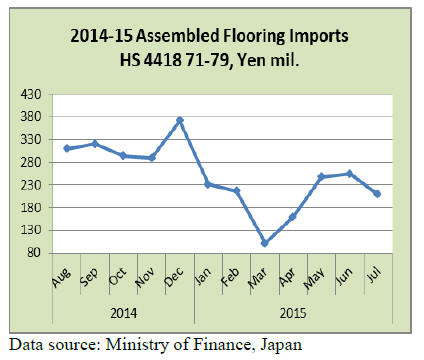
Plywood
While total plywood imports picked up in July, shipments
to Japan from the main suppliers were mixed. China does
not feature prominently in the ranking of Japan‟s plywood
suppliers as the main emphasis is on Indonesia and
Malaysia.
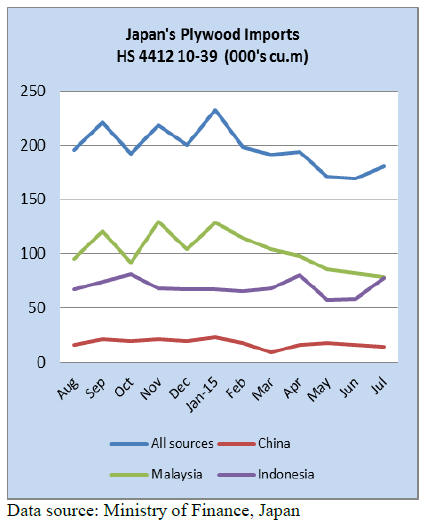
Plywood imports from Malaysia fell sharply in July (-
28%) while imports from Indonesia rose by over 30% to
fill the gap. However, despite the improvemment in
Indonesia‟s shippments in July 2015 they were down 12%
year on year. The good news for Indonesian plywood
exporters is that compared to June this year exports to
japan rose just over 33%.
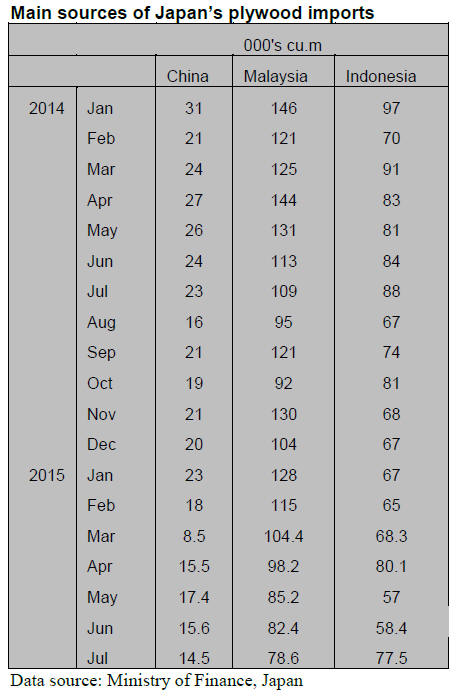
Trade news from the Japan Lumber Reports (JLR)
For the JLR report please see:
http://www.nmokuzai.
com/modules/general/index.php?id=7
First half 2015 log and lumber exports surge
Log and lumber export for the first half of this year were
10,960 million yen in value, 33.8% more than the same
period of last year. High growth continues and the value
exceeded ten billion yen in six month.
For Korea, log exports doubled in volume and lumber
increased by 50% but the volume is oversupplied so that
the shipments are slowing down now. Log shipments to
Taiwan are also slowing. Second half export depends on
purchase by China.
Log export in value is 4,628 million yen, 46.2% more with
the volume of 323,850 cbms, 36.2% more while the
lumber export was 1,690 million yen in value, 15.9% more
with the volume of 31,158 cbms, 5.3% less. Growth in
value depends on sales of higher value species like cypress
particularly for Korea.
In log export, China had 191,763 cbms, 37.1% more and
Korea had 85,920 cbms, 108.2% more. In lumber
shipments, Korea had 4,214 cbms, 51.7% more but China
had 13,591 cbms, 0.1% less.
Plywood mills continue production curtailment
Major plywood manufacturers of softwood plywood will
continue production curtailment in September.
July shipment was 252,500 cbms, renewed record high
monthly shipment next to last June and the inventories
were sharply down to 186,100 cbms, 46,100 cbms less
than June inventories so delivery period for new orders are
uncertain but the manufacturers think that supply
reduction is necessary to tighten the market.
August is vacation month so the production drops while
the users are anxiously pushing the mills early deliveries
in an anticipation of higher market in tight supply. The
manufacturers try to judge if such orders are based on
actual demand or speculative purchase. To find out if the
demand is real or not, the manufacturers decided to
continue production curtailment in September and see
what reaction the market shows in September.
Large users like precutting plants suffer some delay of
shipment but it is not serious stage yet. July production
was 199,500 cbms, 6.4% less than June. That in June 2014
was 230,000 cbms.
Back ground of this action by the manufacturers is long
deep market slump since last January through June. The
dealers minimized the purchase in down market. In this
situation, the only solution is production curtailment and
when the inventories decline, the dealers started buying in
large volume and recorded high shipment for two straight
months.
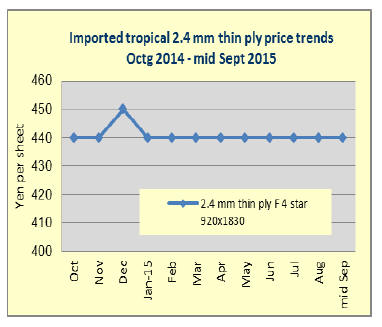 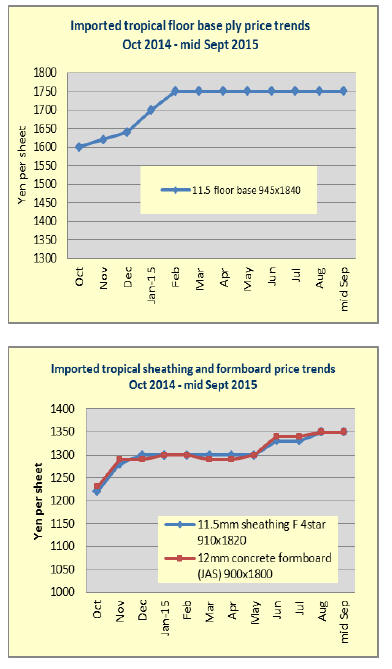
North American log and lumber imports for the first
half of the year
Import of North American logs and lumber decreased for
two straight years. Log import for the first six months of
this year decrease by nearly 30% from the recent peak of
2013. Total log import for the first six months of this year
was 1,281,723 cbms, 26.3% less than the same period of
last year.
European lumber imports for the first half of this year
Import of European lumber during January and June this
year was 1,144,000 cbms, 19.2% less than the same period
of last year due to slower demand. This is the lowest first
half import in last five years.
Structural laminated lumber market was inactive so that
import of lamina from major sources decreased. However,
since last spring, import from Austria, Estonia and Czech
increased after whitewood KD stud supply declined and
the inventory dropped in Japan.
The demand changed so much compared to the first half of
last year when the demand increased before the
consumption tax increase since April.
Monthly import during January and June last year was
about 250,000 cbms but for first three months this year,
monthly import had been less than 200,000 cbms although
it increased to 210,000 cbms in April and May.
South Sea (tropical) log and lumber imports for the
first half 2015
Imports of logs and lumber for the first half of the year
decreased by 15% compared to the same period of last
year. Import of logs from major sources of Sabah and
Sarawak, Malaysia declined by high FOB prices, weaker
yen and depressed market in Japan. See the chart for
volume by source.
Total log import was 114,800 cbms, 14.8% less out of
which Malaysian logs were 96,100 cbms, 15.8% less.
Malaysian supply takes about 85% of South Sea log
import so decline of Malaysian supply pulled down total
volume. If this low level continues, total year import
would be about 230,000 cbms, the lowest ever.
Limited supply in producing regions pushed FOB higher
then the yen depreciated since last summer so the yen cost
soared. The cost of Sarawak meranti regular was about
10,000 yen up until August last year then it has kept going
up and now it is about 13,000 yen per koku.
For plywood manufacturers, it is impossible to pass this
high cost onto sales prices in depressed market so they
seek substituting sources, which is another reason
Malaysian log import decreased.
|